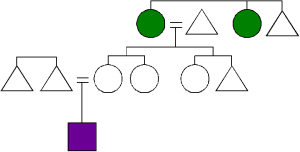![]()
![]()
![]()
![]()
mārja
isn’t actually a kinship term. mārja refers to the female head of the clan, who is usually one of the older females in the clan.
![]()
![]()
![]()
![]()
mārja
isn’t actually a kinship term. mārja refers to the female head of the clan, who is usually one of the older females in the clan.
![]()
![]()
![]()
![]()
![]()
![]()
![]()
mārjanen
one’s grandmother, mother’s mother, great-aunt, any female kin of one’s mother’s mother’s generation. The green circles are the purple square’s mārjanni:

![]()
![]()
āñ
The modifier āñ is related to the word jāña, “middle”, So, āñ generally concerns itself with middle-ness. Combined with the directional prepositions, rā and rū, the concept becomes less clear. For example, rā NP āñ means, predictably, into the middle of NP or amid/amidst/among NP. If the NP is a large area, however, it can mean throughout NP. rū NP āñ, in contrast, means around NP or surrounding NP. So, with rā, āñ denotes a space (NP) and the thing spoken of is inside that space, not near an edge, and possibly in multiple spots inside that space. With rū, āñ again denotes a space (NP), but now the thing spoken of is specifically not inside that space, but rather outside of it, at multiple spots outside of it.
![]()
![]()
![]()
![]()
![]()
rājāñ
rājāñ is rā NP āñ without a specified location, and so means ‘to the middle’, ‘to among’, or ‘throughout’.
![]()
![]()
![]()
![]()
![]()
rūjāñ
Likewise rūjāñ is rū NP āñ without a specified location, and so means ‘surrounding’ or ‘around’.
Examples:
ñamma sāim makkepōlien rā anmārwi āñ pēxa
They became scattered throughout the world.
[pēxa is there for emphasis]
ñi sāim rū sāen āñ;
They gathered around him.
Note: That’s it for motion and direction, for now anyway. Feel free to ask questions about anything I didn’t cover. Next up, kinship and clan words, for a bit. After that, I’m not sure. Leave me a suggestion.
![]()
![]()
![]()
![]()
ālme
The modifier ālme is related to the noun jālme, which means ‘ford, crossing’. So the central definition of ālme denotes crossing something long and narrow from one side to the other, very much like ‘across’. ālme has expanded its range to include crossing any area, from one side of the area to the other side of the area. One border to the area must also be crossed. So one can start inside the area (at the edge, but inside) and cross to outside the area, or from outside the area to the opposite inside edge of the area, or from outside the area through the area and across the next border to outside the area again.
rā NP ālme is across NP and rū NP ālme is from across NP.
![]()
![]()
![]()
![]()
![]()
![]()
![]()
rājālme
rājālme is rā NP ālme without a specified location, and so means ‘across’.
![]()
![]()
![]()
![]()
![]()
![]()
![]()
rūjālme
Likewise rūjālme is rū NP ālme without a specified location, and so means ‘from across’.
ñi jahāþa rā jatōna ālme tō-kēñ;
Why did the “chicken” cross the road?
tō ñi rājakiē;
To get to the other side.
![]()
![]()
![]()
![]()
![]()
sālne
one’s smile. This might be more familiar to some as jālne as in:
sele jālne to anmāe;
‘I really like tea.’ or ‘Tea makes me happy.’
The stem -āln- can refer to the smile as a facial expression, in which case it is generally possessed, or as an indication of a feeling, in which case it is not possessed. This is true of most words that can be seen as bodily expressions.
![]()
![]()
![]()
![]()
sāka
one’s finger or fingers.
Fingertips are sāka japēxa, and fingerprints (in case anyone is translating any crime stories) are sāka jatewēlre.
![]()
![]()
![]()
![]()
![]()
![]()
sārena
one’s animating spirit, that which makes one self-moving. sārena separates animals from plants.
![]()
![]()
![]()
![]()
![]()
![]()
anāste
black: the color of the clear night sky and the depths of the sea. Anything else black, either translucent or otherwise appearing to have depth, can be described as anāste.
[I’ll do color terms for a week or two, but then I’m serious about wanting a new topic.]
![]()
![]()
![]()
![]()
![]()
![]()
![]()
jāllōhen
a large communal meal, a feast.
se jāllōhen jahē cī;
“Have a good feast.”